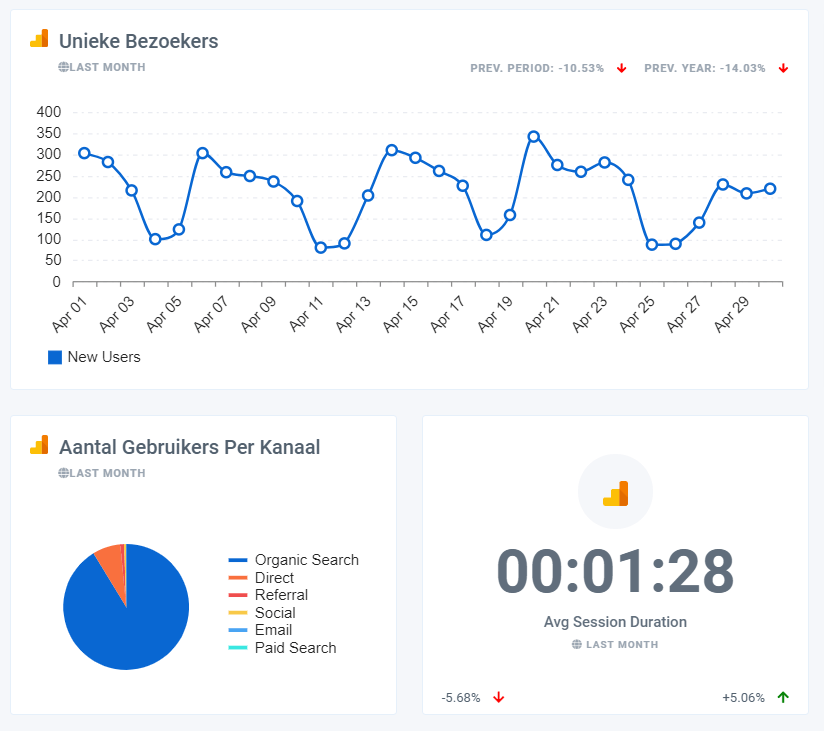*Online Marketing
Creating a Content Strategy in 4 Steps

Content marketing is indispensable nowadays. Yet there are still plenty of companies that are not actively engaged in creating and disseminating valuable content to reach their target audience. Are you ready to get started with content marketing? We’ll show you in 4 simple steps how to develop a content strategy. After reading this blog, you can immediately start with your content strategy and content marketing!
Content marketing forms the basis of your SEO strategy
“Being found on Google” is a desire in many organizations. And rightly so! Online is becoming increasingly important, and this trend is not likely to decrease, partly due to the advent of “Voice Search.” But how do you achieve that? With a solid SEO strategy and content strategy.
What is a content strategy?
Content marketing is a strategic marketing approach focused on creating and distributing valuable and relevant content, with the ultimate goal of attracting or retaining a clear target audience.
A strategic approach, therefore, requires a content marketing strategy. Your strategy becomes the guiding principle in your content marketing, so you don’t have to rethink what’s needed every week or every month. How do you create this strategy? In advance, decide what content you will create, for what purpose, for whom, and how you will distribute it. These four elements together make up your content marketing strategy.
A successful content strategy in 4 steps
Content marketing comes in many different forms and flavors; you can make it as simple or as complex as you like. But, as with many other things, we recommend starting with a basic content strategy. In these 4 steps, you’ll create a content marketing strategy:
1. The goal of content marketing and KPIs
2. Determining the target audience and their content preferences
3. Content ideas and topics
4. Content distribution: distributing content
We will guide you through this process and explain at each step how to determine your content marketing strategy. Finally, we’ll give you a tip for your content calendar and content production.
The goal of content marketing and KPIs
Step 1 of a successful content strategy is to determine your goal. What do you want to achieve? This can be very broad because your content strategy can serve various purposes. Ask yourself what the highest achievable online goal is for your organization. Is it an online sale? Or acquiring a lead? Work backward to practical and, above all, measurable goals from that point.
For Merkelijkheid, our primary goals, for example, are:
Consultation, a potential customer has a question and wants to schedule a consultation.
Appointment request, a potential customer wants to schedule an introductory meeting.
Conversion, signing up for our newsletter.
Then think about which data could be good KPIs (Key Performance Indicators). Also, consider other online goals and how they contribute to the main goal. Think, for instance, of website visitors, followers on social media, newsletter subscriptions, or sample requests.
If you’re just starting with content marketing or online marketing in general, this can be challenging. You mainly think about the customer journey and how you can turn the target audience into customers. This might cause you to focus too much on the final steps in the process, limiting the number of opportunities.
Fortunately, this becomes easier over time because you learn a lot about your customers and target audience through online marketing. You also develop a good sense of cause and effect. For example, you learn that more visitors lead to more requests, while the percentage that becomes a customer remains the same. This enables you to make a well-informed choice between attracting more visitors and increasing the conversion rate.
You now know what the main online goals are and how smaller KPIs support them. Turn these into measurable, realistic goals! How many leads do you want to generate in the first three months and in the first year? Do you want to double or quadruple the number of visitors to your website? Formulate clear goals and link the appropriate KPIs to them.

Some examples of KPIs (Key Performance Indicators) for content marketing include:
1. The number of unique visitors to your website.
2. The number of visitors from search engines.
3. Your bounce rate.
4. The number of followers on social media.
5. The click-through rate of your social media posts.
6. The number of new newsletter sign-ups.
7. And, of course, the number of leads generated.
Determining the target audience and their content preferences
Do you know who your target audience is? A successful content marketing strategy caters to the preferences of your target audience, so it’s essential to know who they are! The more you know about your target audience, the greater your chances of success. Therefore, think not only about who you want to reach but also about what they want to know and where their needs lie.
You can make this as complex or as simple as you like. In any case, always conduct keyword research! Not only does it teach you a lot about the search terms your target audience uses and where you want to be found, but it also provides insights into the information they are looking for. Also, look at the content you (unconsciously) already provide. Which pages on your website are frequently viewed, and which social media posts generate the most interaction with your target audience?

Also, have conversations with colleagues who have a lot of contact with the target audience, such as sales or customer service. What questions and themes are relevant to the target audience and the market? If you want even more insight into your target audience, information directly from the source is invaluable! Consider having a brief conversation with some (recent) customers about their experiences and customer journey.
The goal is to have a clear understanding of who your content is for and what content they need.
Content ideas and topics
Now that you know where the target audience’s needs lie, you can start brainstorming topics and ideas. Use all the information you’ve gathered to come up with a variety of topics and content formats. If you’re a service provider looking to share information about new regulations, a blog post might be the best format. Or if you want to dive deeper into the subject matter, consider sharing a whitepaper. Also, think back to that customer journey of your target audience and try to offer multiple types of content on the same topic for different moments and preferences during the customer journey.

Determine which topics have priority and what different types of content you want to create for them. Our tip? Keep it manageable. A list of 10 blog posts for the first 3 months is much easier to execute than a multi-year plan with an endless list of topics and content ideas. The actual creation of content is often underestimated, so taking small steps makes the strategy more feasible.
Content distribution: content distribution
How will you ensure that your content reaches your target audience?
With a well-functioning website and a successful SEO strategy, there is a good chance that your content will be found by the target audience. However, in the beginning, this is not always the case, especially when you are tackling a new topic or a new target audience. After all your hard work, you naturally want your content to reach (potential) customers.

How do you ensure that your blog, whitepaper, or video reaches your target audience? The answer is content distribution, and it goes beyond just posting your content online. As an example, let’s take a blog about beach towels. You’ve written a series of fantastic blogs about the different types of materials, sizes, and designs. You’ve posted the blogs on your website. And then what? Think about other channels, opportunities, and moments to share the blogs. For example, various social media channels, your newsletter, or a social media ad. And why not share the blogs again when the beach season starts again a year later?
Content Calendar and Content Creation
Congratulations, you’ve developed a content marketing strategy! Now it’s time to create content. With a content calendar, you can keep track of content production and deadlines. In a content calendar, you plan when and what content you want to publish and share, set deadlines, and assign content creation responsibilities.
There are various ways to create a content calendar, and the internet is filled with templates and tools. If you’re just starting with content and working with a small team, a simple Excel spreadsheet might suffice. If you have a larger team working on content, it may be worth looking into online tools.
Now, finally, to the heart of the matter: content creation. Get to work. You’ve decided what content to create, for whom, with what goal, and when. All the ingredients are there; now it’s time to produce the product! Start with a clear list of the content you’re going to create and begin. Schedule regular time to work on your content and ensure the plan is feasible. Soon, you’ll see that the strategy you’ve outlined is workable, keeping your content production efficient and enjoyable.
Are you looking for more information on online marketing? Visit our online marketing page, where we gather all our knowledge and tips.